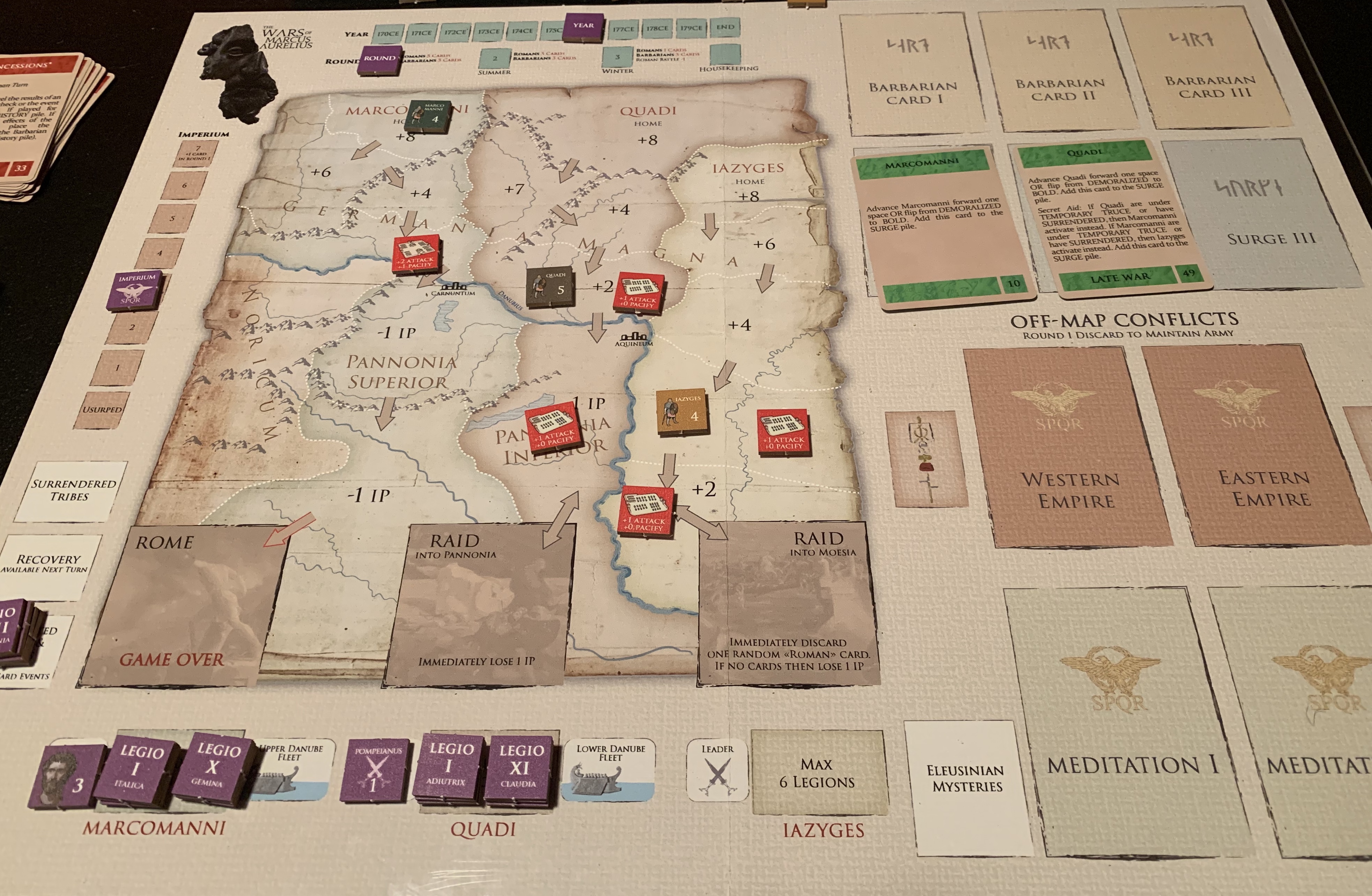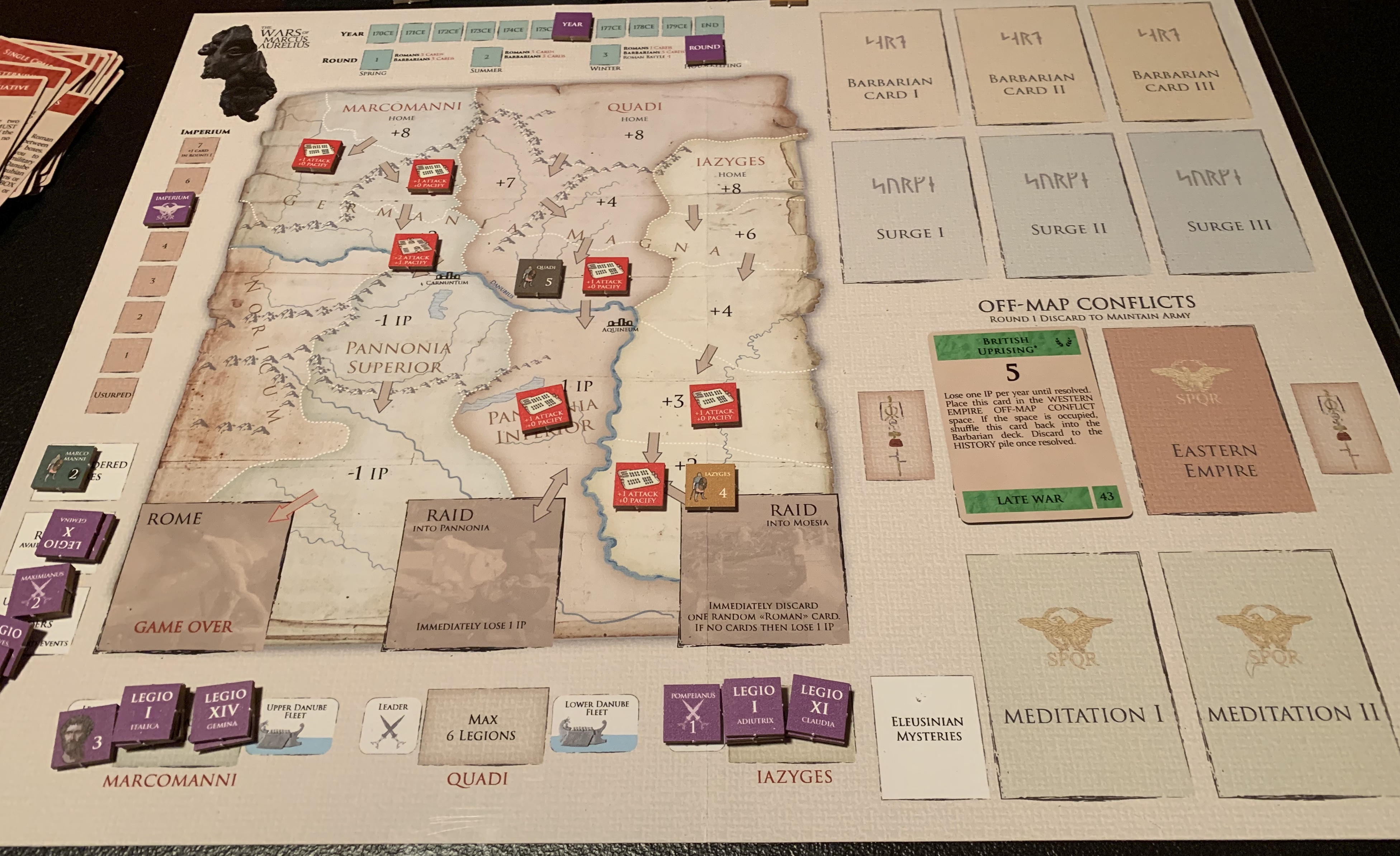Turn Seven, 176 CE

Spring
Aurelius is furious that the Marcomanni would dare to take up arms against Rome again. He personally leads six legions, planning to handle the Marcomanni once again. Meanwhile, he instructs Pompeianus to take six legions and engage the Quadi. The frontier forts will have to hold the Iazyges for now.
The Spring of 176 CE saw scandal and plague rock Aurelius’s armies. Faustina, Aurelius’s recently deceased wife, was revealed to be cavorting with gladiators in Rome while Aurelius was on campaign. Vicious rumors suggested that Aurelius’s son Commodus was in fact the son of a common gladiator. Rumors of his wife’s infidelity made Aurelius a laughing stock among the troops (again), just in time for Plague to sweep through the ranks, decimating once of Pompeianus’s legions.
The Iazyges Cavalry returned to the battle field, destroying a border fort and advancing to the edge of Moesia, with only a single damaged fort keeping them from sacking the vulnerable territory. The Iazyges action emboldened both the Quadi, who destroyed a border fort, and the Marcomanni, who began the long march towards Rome.
Aurelius embarks on a campaign of fort building, fortifying the border with the Iazyges tribe and adding forts to both the Quadi and Marcomanni fronts, and improving the forward fort on the Quadi front. (Samartia to flip one fort and build a level 2 fort on the Iazyges front, discard to build forts on Quadi and Marcomanni front, discard to upgrade Quadi front fort). Aurelius invests in his Imperium, hoping to maintain control of his legions this year.
Finally, Pompeianus’s depleted legion marches against the Quadi, hoping to push them back with the help of the newly constructed fort. Unfortunately, the Quadi are able to outmaneuver Pomepeianus, and one of his legions is dispersed in the retreat. (Roman strength 8 (5 legions +1 Pompeianus +2 fort) vs. Quadi strength 7 (5 +2 terrain). Pomepeianus rolls a 2 and the Quadi roll a 5, resulting in totals of 10 and 12, with a Roman loss).
Summer
Summer sees a massive campaign from the Barbarian armies. The Marcomanni advance and then destroy the Roman frontier fort. The Quadi stage a ferocious attack on the Roman frontier fort on their front, completely eliminating it. The Iazyges get in on the action as well, reducing the Roman fort on their front. (Drew Marcomanni and two Quadi activations. Surge happens, activating Marcomanni and Iazyges).
Aurelius is able to trade on Rome’s reputation, spreading tales of veteran legions coming to crush the Marcomanni and Iazyges, demoralizing the tribes. Aurelius also commissions a fine column in Rome, celebrating his (mostly fictional) triumphs over the Barbarians. The ostentatious display of wealth improves his standing among the Senate and People of Rome. (Column of of Marcus Aurelius for +2IP). Aurelius again contracts with local guides, planning to use them to his advantage when the time is right.
Winter
In a stroke of luck for Aurelius, all is quiet on the Danube, as the Barbarians seek out winter quarters.
Aurelius uses the reprieve to continue his fortification efforts, building forts on the Quadi and Marcomanni fronts. One Roman fort, the strongest fort on the Iazyges front, suffers attrition and is reduced.
Aurelius is aware that he is aging, and that he may not be able to defeat the Barbarian tribes before his death. Resolved to ensure that he leaves a better situation for his heir, Aurelius resolves to focus on ensuring the submission of the Marcomanni, and then the Iazyges, and to hold the Quadi on the far side of the Danube.
Turn Eight, 177 CE

Spring
Aurelius once again led his six legions personally on the Marcomanni front, hoping that they would stay demoralized, allowing for a series of rapid victories. Pompeianus would deploy on the Iazyges front, hoping to push the horse warriors back. Once again, the Roman forts were left to stand alone, but this time against the might of the Quadi.
The Barbarians surge forward again, taking advantage of a plague that once again swept through Pompeianus’s legions. The Iazyges found their confidence again, and the Quadi destroyed the fort on the Danube. No major breakthroughs occured, however, and the Marcomanni remained demoralized.
Aurelius ordered his legions to march on the demoralized Marcomanni. They fought a quick battle, forcing the Marcomanni to retreat away from the Roman forts. The well ordered retreat allowed the Marcomanni to restore their morale, however, and promised harder fights ahead. (Roman strength 10 (6 legions +3 Aurelius +1 fort) versus Marcomanni strength 6 (2 +4 terrain). Aurelius rolls a 4 and the Marcomanni roll a six, for results of 14 and 12, respectively. Because the Marcomanni roll a six, they flip to their bold side).
Aurelius calls on his local guides and again launches an assault against the Marcomanni. Unfortunately, this time, the Marcomanni were ready for his advance. Aurelius’s local guides had been bribed, and led him into a trap. Aurelius led his legions valiantly, but they were unable to overcome the Marcomanni and were forced to retreat, taking heavy losses. (Roman strength 9 (6 legions +3 Aurelius) versus Marcomanni strength 7 (4 +3 terrain, halved due to local guides). Aurelius rolls a 2 and the Marcomanni roll a 5, resulting in totals of 11 and 12, respectively. Aurelius loses, losing a legion).
Finally, Aurelius ordered new forts to be built along the Marcomanni and Quadi fronts.
Summer
In the Summer of 177 CE, Aurelius held his second Lectisternium, a ceremony intended to gain the favor of the gods. Tales of a plague sweeping the region spread throughout the army, but the plague itself never arrived. Moreover, the Barbarians were strangely silent. The legions credited Aurelius’s piety for the results. (Play Lectisternium, cancelling Plague Worsens and ending the Barbarian draw).
Aurelius determines that only a serious campaign of fort building will allow the Romans to overcome the Marcomanni. Once the forts are built and improved, he intends to seize the initiative and destroy the Marcomanni. (Build 2 forts on the Marcomanni front and improve one).
Aurelius engages the Marcomanni in a pitched battle, relying on the newly constructed and improved Roman fort for support. Initiative swings several times during the battle, and at one point it looked like the battle was lost. Just at that moment, Aurelius executed his masterstroke. An entire legion had disengaged from the right flank and infiltrated behind the Marcomanni horde. Just as the Romans seemed to be breaking, a fresh legion charged the Marcomanni from behind. The Marcomanni broke and run, with many slaughtered under the force of Roman arms. (Play Seize the Initiative for two battles. First battle: Roman Strength 10 (5 legions +3 Aurelius +2 fort) versus Marcomanni strength 10 (4 +6 terrain). Initial rolls are 2/2 and 4/4, resulting in ties. On the third roll, Aurelius rolled a 6 and the Marcomanni rolled a 1, for a final result of 16 to 11. Aurelius gains 1IP for his inspired leadership, and the Marcomanni are demoralized.)
Aurelius was not done, however. Feeling the favor of Jupiter Optimus Maximus and the divine Augustus, Aurelius pushed his legions forward into the heart of Marcomanni territory, supported by a hastily constructed fort. Aurelius baited the Marcomanni into attempting to besiege the fort, but the Romans were surprised at the sophisticated siege engines constructed by the Marcomanni. Aurelius, looking on from the walls of the fortress, pointed at the siege engine and called on the gods for aid. Just as he did so, a bolt of lightning struck, destroying the siege engine and scattering the Marcomanni. Aurelius’s legions were able to clean up the remaining Marcomanni and return them to subjugated status. The legions spoke in hushed terms of the lightning miracle, and word was handed down to carve the image onto the Column of Marcus Aurelius. The image was also to be placed on the coinage for 178 CE. (Play Lightning Miracle to automatically win battle. The Marcomanni surrender, and Aurelius gains 1IP.)
Winter
The Quadi destroy the fort on the Danube (again), and the emboldened Iazyges destroy a frontier fort as well. The Marcomanni remain subjugated, thanks to the substantial Roman occupying presence. Barbarian dissidents destroy the fort in the Marcomanni home region, however, and reduce the fort adjacent to the home region. Finally, the Britons revolt, which will likely take needed legions away from the front.
Aurelius spends the winter rebuilding forts on the Quadi and Iazyges borders, hoping to protect Pannonia and Moesia from Barbarian attack.
The winter is mild, and no forts suffer attrition. The conflict with the Britons will be a continuing drain on resources, reducing IP by 1.
